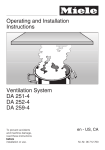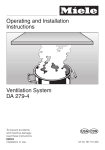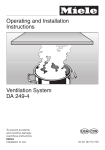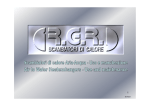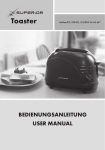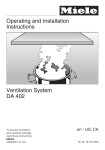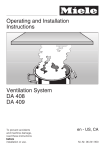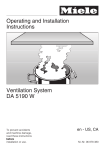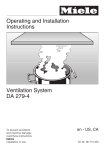Download Miele DA 289 Operating instructions
Transcript
Operating and Installation Instructions Ventilation System DA 289-4 To prevent accidents and machine damage, read these instructions before installation or use. UV M.-Nr. 06 713 760 Contents IMPORTANT SAFETY INSTRUCTIONS Functional description Guide to the hood Operation Turning on the fan . . . . . . . . . . . . . . . . . . . . . . . . . . . . . . . . . . . . . . . . . . . . . . . . . 10 Selecting the power level. . . . . . . . . . . . . . . . . . . . . . . . . . . . . . . . . . . . . . . . . . . . 10 Delayed Shut Down . . . . . . . . . . . . . . . . . . . . . . . . . . . . . . . . . . . . . . . . . . . . . . . . 12 Turning off the fan . . . . . . . . . . . . . . . . . . . . . . . . . . . . . . . . . . . . . . . . . . . . . . . . . 12 Turning the lighting on/off . . . . . . . . . . . . . . . . . . . . . . . . . . . . . . . . . . . . . . . . . . . 13 Dimming the lighting . . . . . . . . . . . . . . . . . . . . . . . . . . . . . . . . . . . . . . . . . . . . . . . 13 Grease filter timer. . . . . . . . . . . . . . . . . . . . . . . . . . . . . . . . . . . . . . . . . . . . . . . . . . 14 Cleaning and care Cleaning the casing . . . . . . . . . . . . . . . . . . . . . . . . . . . . . . . . . . . . . . . . . . . . . . . . 16 Grease filter and air intake panel. . . . . . . . . . . . . . . . . . . . . . . . . . . . . . . . . . . . . . 17 Changing the light bulbs . . . . . . . . . . . . . . . . . . . . . . . . . . . . . . . . . . . . . . . . . . . . 19 After Sales Service Installation instructions Caring for the environment Installation accessories Plywood backing Electrical data Appliance dimensions Installation Installation instructions . . . . . . . . . . . . . . . . . . . . . . . . . . . . . . . . . . . . . . . . . . . . . 30 Dismantling . . . . . . . . . . . . . . . . . . . . . . . . . . . . . . . . . . . . . . . . . . . . . . . . . . . . . . 30 Air extraction Condensate trap . . . . . . . . . . . . . . . . . . . . . . . . . . . . . . . . . . . . . . . . . . . . . . . . . . 32 2 IMPORTANT SAFETY INSTRUCTIONS Read these Operating Instructions carefully before installing or using the Ventilation System. This appliance is intended for residential use only. Use the appliance only for its intended purpose. The manufacturer cannot be held responsible for damages caused by improper use of the hood. This appliance complies with current safety requirements. Improper use of the appliance can lead to personal injury and material damage. READ AND SAVE THESE INSTRUCTIONS CAUTION Use only for general ventilation. Do not use to exhaust hazardous or explosive materials and vapors. This appliance is designed to vent cooking smoke and odors only. Be certain your appliance is properly installed and grounded by a qualified technician. To guarantee the electrical safety of this appliance, continuity must exist between the appliance and an effective grounding system. It is imperative that this basic safety requirement be met. If there is any doubt, have the electrical system of the house checked by a qualified electrician. The manufacturer can not be held responsible for damages caused by the lack, or inadequacy, of an effective grounding system. Before connecting the appliance to the power supply make sure that the voltage and frequency listed on the data plate correspond with the household electrical supply. This data must correspond to prevent machine damage. If in doubt consult a qualified electrician. Installation work and repairs should only be performed by a qualified technician in accordance with all applicable codes and standards. Repairs and other work by unqualified persons could be dangerous and the manufacturer will not be held responsible. 3 IMPORTANT SAFETY INSTRUCTIONS This equipment is not designed for maritime use or for use in mobile installations such as recreational vehicles or aircraft. However, under certain conditions it may be possible for an installation in these applications. Please contact the nearest Miele dealer or the Miele Technical Service Department with specific requirements. Before servicing or cleaning the unit, switch power off at the service panel and lock the service disconnecting means to prevent power from being switched on accidentally. If the service disconnecting means cannot be locked, securely fasten a prominent warning device, such as a tag, to the service panel. Before discarding an old appliance, unplug it from the power supply and remove the power cord and any doors to prevent hazards. Use Do not allow children to play with or operate the appliance or its controls. Supervise its use by the elderly or infirm. Do not flambé or grill with an open flame beneath the hood. Flames could be drawn up into the hood by the suction and the grease filters may catch fire. Never operate gas burners without cookware. Turn the burner off when not in use. Adjust the burner so that the flames do not extend beneath the cookware. Do not overheat the cookware, e.g. when using a wok. The hood can be damaged due to excessive heat from the burners and the cookware. Do not use the hood without the grease filters in place. Clean the grease filters regularly. Dirty filters are a fire hazard. Do not use a steam cleaner to clean the hood. Steam could penetrate electrical components and cause a short circuit. Always turn on the hood when using the cooktop to prevent damage from condensation. 4 IMPORTANT SAFETY INSTRUCTIONS , WARNING - TO REDUCE THE RISK OF A COOKTOP GREASE FIRE: Never leave surface units unattended at high settings. Boilovers cause smoking and greasy spillovers may ignite. Heat oils slowly on low or medium settings. Always turn the hood on when cooking at high heat. Clean ventilating fans frequently. Grease should not be allowed to accumulate on fan or filter. Use proper pan size. Always use cookware appropriate for the size of the surface element. , WARNING TO REDUCE THE RISK OF INJURY TO PERSONS IN THE EVENT OF A RANGE TOP GREASE FIRE, OBSERVE THE FOLLOWING: SMOTHER FLAMES with a close fitting lid, cookie sheet, or metal tray then turn off the burner. BE CAREFUL TO PREVENT BURNS. If the flames do not go out immediately, EVACUATE AND CALL THE FIRE DEPARTMENT. NEVER PICK UP A FLAMING PAN - You may be burned. DO NOT USE WATER, including wet dishcloths or towels - a violent steam explosion will result. Use a fire extinguisher ONLY if: – You have a Class ABC extinguisher, and you know how to operate it. – The fire is small and contained in the area where it started. – The fire department is being called. – You can fight the fire with your back to an exit. 5 IMPORTANT SAFETY INSTRUCTIONS Installation , WARNING To reduce the risk of fire only use metal ductwork. Provided a larger distance is not given by the manufacturer of the cooktop, follow the recommended minimum safety distances between a cooktop and the bottom of the grease filter of 30" (762 mm). See "Appliance Dimensions" for more information on optimum installation heights. If local building codes require a greater safety distance, follow their requirement. If there is more than one appliance beneath the hood and they have different minimum safety distances always select the greater distance. Be careful not to damage hidden electrical wiring or plumbing when cutting or drilling into the wall or ceiling. Do not use an extension cord to connect the appliance to electricity. Extension cords do not guarantee the required safety of the appliance, (e.g. danger of overheating). Do not install this hood over cooktops burning solid fuel. 6 Any fittings, sealant, or materials used to install the ductwork must be made of approved non-flammable materials. Never connect an exhaust hood to an active chimney, dryer vent, vent flue, or room ventilating ductwork. Seek professional advice before connecting an exhaust hood vent to an existing, inactive chimney or vent flue. Ducted fans must always be vented outdoors. Make sure that the airflow in the room is sufficient for combustion and exhausting of all non-electric heating appliances (water heaters, gas cooktops, gas ovens, etc.), otherwise backdrafts may occur. Follow the heating manufacturer’s guidelines and safety standards or those published by the National Fire Protection Association (NFPA) or the American Society for Heating, Refrigeration and Air Conditioning Engineers (ASHRAE). If in doubt, consult an experienced professional. Functional description The ventilation hood works by air extraction. The air is drawn in and cleaned by the grease filter and directed outside. The hood comes equipped with a non-return flap. This flap automatically closes when the hood is turned off so that no exchange of outside air and room air can occur. When the hood is turned on, the air pressure of the exhaust fan automatically opens the flap blowing the inside air and cooking odors outside. 7 Guide to the hood 8 Guide to the hood a Chimney extension h Light button b Chimney This button dims the light or turns it on and off. c Canopy The lighting can be used independently of the fan. d Control panel e Overhead lighting i On/Off button j Fan power selection f Grease filter Four fan speed selection g Air intake panel k Delayed Shut Down This button activates the Delayed Shut Down feature. The fan can be set to turn off automatically after either 5 or 15 minutes. l Grease filter button The indicator next the grease filter button lights when the grease filter and air intake panel need to be cleaned. This button is also used: – to reset the grease filter timer after cleaning the grease filter and air intake panel (see "Cleaning and Care"). – to show how long the grease filter has been in use (see "Operation / Filter timers"). – to change the number of hours counted by the grease filter timer (see "Operation / Reprogramming the grease filter timer"). 9 Operation Turning on the fan Automatically switching back the intensive power level The intensive level "4" can be programmed to automatically switch back to level "3" after 10 minutes. ^ Press the On/Off button. Selecting the power level ^ Use the "–/+" controls to select the desired power level. + = increases the fan speed – = decreases the fan speed ^ Turn the fan and the lights off. ^ Press and hold the "Delay Shut down" button for 10 secs. The first indicator lights. ^ Press the following buttons one after another, Levels "1" to "3" (green indicators) are usually sufficient for normal cooking. Intensive setting – light Level "4" (yellow indicator) should be used for a short period when frying or cooking food with a strong aroma. – the "–" button, and – the light button again. 10 Operation Fan performance If the power level indicators "1" and "4" flash the automatic switch back is not activated. ^ To activate the automatic switch back press the "+" button. The maximum air flow capacity is 625 cfm. Factors such as narrow duct diameter and bends will affect this value. Level 1 operates at 40% capacity Level 2 operates at 60% capacity Level 3 operates at 80% capacity Level 4 operates at 100% capacity The power level indicators "1" and "4" light continuously. ^ To save the setting press the "Delay Shut Down" button. If the procedure is not stored within 4 minutes of programming, the hood will automatically default to the "old" data. 11 Operation Delayed Shut Down If odors or smoke remain in the kitchen after cooking has been completed, the Delayed Shut Down feature can be selected to allow the hood to continue running for either 5 or 15 minutes. Turning off the fan ^ Press the On/Off button to turn the fan off. The indicator goes out. ^ Press the Delayed Shut Down button while the fan is still running. Press once = 5 minute delay (left indicator lights) Press twice = 15 minute delay (right indicator lights) To cancel the Delayed Shut Down feature press the button again. 12 Automatic Safety Shut Off The fan will turn off automatically 10 hours after the last button was activated. The lighting however will remain on. ^ Press the On/Off button to turn the fan back on again. Operation Turning the lighting on/off Dimming the lighting The overhead lighting can be turned on and off independently of the fan. The brightness of the lighting can be adjusted. ^ While the lighting is turned on, press the light button. The lighting will dim until the button is released. ^ Press the light button briefly to turn on the lighting. The light button indicator illuminates. ^ Press the light button briefly again to turn off the lighting. The light button indicator will go out. ^ If the button is pressed again, the lighting will brighten until the button is released. If the button is pressed continuously, the light will cycle between bright and dark. ^ Press the light button again to turn off the lighting. 13 Operation Grease filter timer Checking the grease filter timer A timer monitors the hours of fan operation. The indicator for the grease filter will light after 30 hours of operation. The grease filter and air intake panel must then be cleaned. To check the percentage of time already used: After the grease filter has been cleaned and put in place, the grease filter timer must be reset. ^ To do this, press the grease filter button for about 3 seconds. ^ Press the On/Off button to turn the fan on. ^ Press the grease filter button. The indicator will go out. The number of flashing "–/+" indicators show the percentage of programmed hours that have been used. 1 indicator = less than 25 % 2 indicators = less than 50 % 3 indicators = less than 75 % 4 indicators = less than 100 % This information will remain stored in memory in the event of a power failure. 14 Operation Reprogramming the grease filter timer The grease filter timer is preset to 30 hours. This time can be lengthened or shortened to 20, 30, 40 or 50 hours. – A time of 20 hours should be programmed in kitchens with frequent pan or deep frying. The indicator for the grease filter and one of the "–/+" indicators will flash. The lit "–/+" indicator shows the programmed time: – A time of 20 hours should also be programmed if the kitchen is only used occasionally to prevent grease which has accumulated over a long period of time from hardening on the filters, making cleaning more difficult. 1st indicator from the left 2nd indicator from the left 3rd indicator from the left 4th indicator from the left ^ Press the On/Off button to turn off the fan. ^ Store the selection by pressing the grease filter button. ^ Press the Delayed Shut Down and grease filter buttons at the same time. = = = = 20 hours 30 hours 40 hours 50 hours ^ Use the "–/+" button to select the desired time. If the procedure is not stored within 4 minutes of programming the hood will automatically default to the "old" data. 15 Cleaning and care Stainless steel Before cleaning or servicing the hood, disconnect it from the power supply by either removing the fuse, unplugging it from the outlet or manually "tripping" the circuit breaker. Cleaning the casing ,Never use abrasive cleaners, scouring pads, steel wool or caustic (oven) cleaners on the hood. They will damage the surface. ^ The air intake panel, exterior surfaces and controls can be cleaned with warm water and liquid dish soap applied with a soft sponge. ^ Wipe dry using a soft cloth. Only use a slightly damp sponge when cleaning the controls. Water could penetrate into the electronics and cause damage. ^ Glass surfaces can be cleaned using glass cleaner. Avoid: – cleaning agents containing soda, acids or chlorides, – abrasive cleaning agents e.g. powder or cream cleansers, – abrasive sponges, e.g. pot scourers or sponges which have been previously used with abrasive cleaning agents, – limescale removers. These will damage the surface. 16 Stainless steel surfaces can be cleaned using a non-abrasive stainless steel cleaner. To help prevent resoiling, a conditioner for stainless steel can also be used. Apply sparingly with even pressure. Stainless steel colored controls These controls may become discolored or damaged if not cleaned regularly. Do not use a stainless steel cleaner on these controls. Cleaning and care Grease filter and air intake panel Removing the air intake panel The reusable metal grease filter removes solid particles from the vented kitchen air (grease, dust, etc). The grease filter and the air intake panel should be cleaned every 3 - 4 weeks or whenever the grease filter indicator lights. Keep the grease filter clean to prevent a fire hazard. ^ To remove the air intake panel gently pull out and downward, shifting the lower part a bit to the right. Lift it out of the latches. Support the air intake panel so that it does not fall onto the cooktop. Removing the grease filter ^ To remove the grease filter, pull on the lever. Support the grease filter so that it does not fall onto the cooktop. 17 Cleaning and care Cleaning the grease filters ^ By hand: use a scrub brush with a solution of warm water and mild detergent. Do not use the pure detergent, aggessive all purpose cleaners, oven sprays or limescale removers. They could destroy the filters. ^ In a dishwasher: place the filters vertically in the lower basket, making sure that the spray arm is not blocked. Use a hot temperature program, e.g. "Heavy Soil" or "Pots and pans". Use the recommended amount of dishwasher detergent. Overuse could destroy the filter. Depending on the detergent, cleaning the grease filter in a dishwasher may cause permanent discoloration of the filter surface. Performance of the filter will not be affected by this discoloration. ^ After cleaning, the filter can be placed on a towel to air dry. ^ Clean the air intake panel according to "Cleaning the casing". ^ While the filter and the air intake panel are removed, clean any dirt or grease from the interior casing to prevent the risk of fire. 18 ^ Push the grease filter back in place. ^ Hook the air intake panel on the latches and push a little to the left. Push it toward the unit so that it clicks in place. ^ After returning the grease filter, press the grease filter button for 3 seconds to reset the timer. The indicator light will go out. ^ If the grease filter and air intake panel are cleaned before the grease filter timer has reached its maximum, the grease filter button should be pressed for 6 seconds to reset the counter to zero. Cleaning and care Changing the light bulbs Before changing the light bulbs, disconnect the hood from the power supply by either removing the fuse, unplugging it, or manually "tripping" the circuit breaker. When in use halogen bulbs become extremely hot, and they can burn your hands. Do not attempt to change the bulbs until they have had sufficient time to cool. Do not touch the bulb surface. Fingerprints or body oils deposited on the bulb will decrease its life. Please follow the bulb manufacturer’s instructions. ^ Pull the old bulb out of its socket using the enclosed lever. Replace it with a new one. Be careful not to drop the bulb on the cooktop. Replacement bulbs may be ordered from Miele’s Technical Service Department. See the phone numbers on the back of this booklet. 19 After Sales Service Repairs MieleCare In the event of a fault which you cannot easily fix yourself, please contact the Miele Technical Service Department at the phone number on the back of this booklet. (only USA) ^ When contacting the Technical Service Department, please quote the model and serial number of your appliance. These are shown on the data plate which is visible when the grease filter is removed. MieleCare, our Extended Service Contract program, gives you the assurance of knowing that your appliance investment is covered by 5 years of worry free ownership. MieleCare is the only Extended Service Contract in the industry that guarantees repairs by a Miele Authorized Service Provider using genuine Miele parts. Only genuine Miele parts installed by factory trained professionals can guarantee the safety, reliability, and longevity of your Miele appliance. Please note that unless expressly approved in writing by Miele’s Service department, Extended Service Contracts offered by other providers for Miele products will not be recognized by Miele. Our goal is to prevent unauthorized (and untrained) service personnel from working on your Miele products, possibly doing further damage to them, you and/or your home. To learn more about MieleCare Extended Service Contracts, please contact your appliance dealer or visit us online at: www.store.miele.com 20 Installation Instructions 22 Caring for the environment Disposal of packing material Disposal of an old appliance The cardboard box and packing materials protect the appliance during shipping. They have been designed to be biodegradable and recyclable. Please recycle. Old appliances may contain materials that can be recycled. Please contact your local recycling center about the possibility of recycling these materials. To prevent suffocation of children, ensure that any plastic wrappings, bags, etc. are disposed of safely and kept out of their reach. Before discarding an old hood, unplug it from the outlet and cut off its power cord to prevent hazards. 23 Installation accessories 24 Installation accessories a 3 protective shields prevent scratches to the chimney during installation. b Upper retaining plate secures the chimney extension. c Middle retaining plate for additional stability of the chimney. d 2 hose clips for securing the ducting. e 1 reducing collar for use with 5" (125 mm) exhaust ducting. Caution: During the installation process, please be careful of sharp edges that can cause harm. 5 large headed screws 5 x 40 mm for securing the retaining plates and the canopy. (S8 wall anchors included in the packaging are not for use in USA / CDN.) 2 screws 5 x 60 mm for securing the chimney. 6 screws 3.5 x 9.5 mm for securing the canopy and filter housing 2 screw covers 1 lever for dismantling the chimney and changing the light bulbs Installation instruction sheet 25 Plywood backing The majority of the weight of the installed ventilation system will be supported by the lower retaining plate. It must be firmly attached to the stud framing behind the drywall. If studs are not available in the required locations, a plywood backing (min. ½" (13 mm) thick) spanning at least two studs must be installed. Failure to adequately support the weight as stated may result in the ventilation system falling off the wall, causing personal injury and property damage. (If plywood backing is not needed, proceed to the included installation sheet.) To install a plywood backing ^ Find the studs to the left and right of the mounting location by tapping the wall or using a stud finder. ^ Mark a vertical cutting line along the center of each stud. Be careful not to damage any wiring or plumbing that may be located behind the wall. Make sure that the power supply to the area where this installation is being performed has been turned off at the breaker panel before cutting into the wall. ^ Remove the drywall between the cutting lines and replace it with plywood of a matching thickness (min. 1/2" (13 mm) thick). Tape the joints and refinish the wall. ^ Proceed to the included installation sheet to complete the installation. ^ Determine and mark the location of the retaining plate for the canopy as outlined on the installation sheet. ^ Make a cutting line 3" (76 mm) above and 3" (76 mm) below the outline of the retaining plate. 26 Electrical data All electrical work should be performed by a qualified electrician in strict accordance with national and local safety regulations. Installation, repairs and other work by unqualified persons could be dangerous. The manufacturer cannot be held responsible for unauthorized work. Ensure that power to the appliance is OFF while installation or repair work is performed. ^ Verify that the voltage, load and circuit rating information found on the data plate (located behind the grease filters), match the household electrical supply before installing the hood. ^ Use only with rangehood cord-connection kits that have been investigated and found acceptable for use with this model rangehood. If there is any question concerning the electrical connection of this appliance to your power supply, please consult a licensed electrician or call Miele’s Technical Service Department. U V 1-800-999-1360 1-800-565-6435 Grounding Instructions This appliance must be grounded. In the event of an electrical short circuit, grounding reduces the risk of electric shock by providing a path of least resistance. This appliance is equipped with a cord having a grounding wire with a grounding plug. The plug must be plugged into an outlet that is properly installed and grounded. WARNING - Improper grounding can result in a risk of electric shock. If there is any doubt, have the electrical system of the house checked by a qualified electrician. The manufacturer cannot be held responsible for damages caused by the lack, or inadequacy, of an effective grounding system. Do not use an extension cord. If the power supply cord is too short, have a qualified electrician install an outlet near the appliance. Important The hood comes equipped with a 4 ft (1.2 m) power cord with a NEMA 1-15 molded plug for connection to a 120 VAC, 60 Hz, 15 A power outlet. Maximum load . . . . . . . . . . . . . . 390 W WARNING: THIS APPLIANCE MUST BE GROUNDED Light. . . . . . . . . . . . . . . . . . . . . 4 x 10 W Voltage . . . . . . . . . . . . . . . . . . . . . 120 V Frequency . . . . . . . . . . . . . . . . . . 60 Hz Circuit rating. . . . . . . . . . . . . . . . . . 15 A 27 Appliance dimensions 28 Appliance dimensions 1) and 2) Cut out area in wall or ceiling for entrance of 6" (150 mm) ductwork or 5" (125 mm) ductwork with a reducing collar. Do not install this exhaust hood over cooktops burning solid fuel. Provided a larger distance is not given by the manufacturer of the cooktop, follow the recommended minimum safety distances between a cooktop and the bottom of the grease filter of 30" (762 mm). If local building codes require a greater safety distance, follow their requirement. Follow the safety distances recommended by the cooktop manufacturer in their installation and operating instructions. Distance between cooktop and hood (S) ^ To observe the safety distance and ensure an optimum function and use of the hood, a distance of S = 14 3/8" (365 mm) between the cooktop and the lower edge of the glass pane is recommended. ^ If the hood is fitted flush to the ceiling, the sum of S + H + Workspace should not exceed the room height. Standard unit height H 37 7/8" - 51 7/8" (960 - 1320 mm) To fit the lower chimney section, the distance between the top of the chimney and the ceiling must be at least 7/8" (20 mm). If there is more than one appliance beneath the hood and they have different minimum safety distances always select the greater distance. See "IMPORTANT SAFETY INSTRUCTIONS" for further information. 29 Installation Installation instructions Dismantling ^ See the enclosed installation instruction sheet. If the hood needs to be disassembled, follow the instructions on the installation sheet in the reverse order. ^ Please read the "Important Safety Instructions" and Installation instructions before installing this hood. A lever is enclosed for easier removal of the chimney extension. Protective film The casing is covered with a protective film to prevent scratching during transport. ^ Peel off the film before installing the casing parts. ^ After removing the screws from the chimney, slide the lever between the chimney and the chimney extension and gently apply pressure to ease the chimney from its hooks. 30 Air extraction ,WARNING Danger of toxic fumes. Gas cooking appliances release carbon monoxide that can be harmful or fatal if inhaled. The exhaust gases extracted by the hood should be vented outside of the building only. Do not terminate the exhaust ducts in attics, garages, crawlspaces, etc. To reduce the risk of fire, only use metal ductwork. Please read and follow the "IMPORTANT SAFETY INSTRUCTIONS" to reduce the risk of personal injury. Follow all local building codes when installing the hood. Exhaust ducting and connections – The ducting should be as short and straight as possible, and the number of sharp bends should be minimized. – For most efficient air extraction, the diameter of the ductwork should not be less than 6" (150 mm). Use of flat ducts also reduces the air extraction efficiency. – Noise levels of the hood will increase if flat ducts or round ducts of less than 6" (150 mm) in diameter are used. – Use smooth or flexible pipes made from approved non-flammable materials for exhaust ducting. – Where the ductwork is horizontal, it must slope away from the hood at least 1/8" per foot (1 cm per meter) to prevent condensation dripping into the appliance. – If the exhaust is ducted through an outside wall, a Miele Telescopic Wall Vent can be used. 31 Air extraction Condensate trap optional accessory If the exhaust is ducted into an inactive flue, the air must be expelled parallel to the flow direction of the flue. Never connect an exhaust hood to an active chimney, dryer vent, vent flue, or room venting ductwork. Seek professional advice before connecting an exhaust hood vent to an existing, inactive chimney or vent flue. Important! If the ductwork runs through rooms, ceilings, garages, etc. where temperature variations exist, it may need to be insulated to reduce condensation. 32 In some cases, a condensate trap may also be required to collect and evaporate any condensation which may occur. This optional accessory is available for ducts 5" (125 mm) and 5 7/8" (150 mm) in diameter. When installing a condensate trap, ensure that it is positioned vertically and if possible directly above the exhaust outlet. The arrow on the casing shows the venting direction. 33 34 35 Alteration rights reserved / 3606 M.-Nr. 06 713 760 / 03 en - USA




































